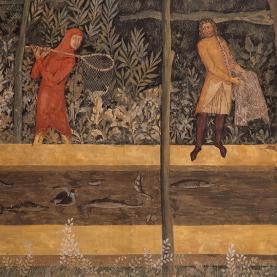Aquaculture techniques
Aquaculture, in a natural or artificial lake, in fresh water or in the sea, requires appropriate techniques and equipment. This kind of farming includes establishing fish and molluscs in their place of growth, artificial reproduction and harvesting. Aquaculture enables large quantities of animals of the same species to be produced for their meat or by-products. Caviar is one example. In 2011, half of the fish eaten worldwide had been farmed.
Requirements of sustainable aquaculture
Aquaculture has been practised for centuries, but, despite many parallels with agriculture, its evolution has been slow, partly because of a lack of knowledge of the environment and of the specificities of aquatic organisms. Since the latter half of the 20th century, demand for salmon, prawns, eels and bass has been rising steadily. Aquaculture has helped to gradually reduce capture fishing, and now accounts for half of the world's production of fish, molluscs, crustaceans and seaweed for food purposes. Aquaculture systems have the potential to help eradicate hunger in the world, which will have a population of over 9 billion by the year 2050, while helping preserve fisheries and, more broadly, the natural environment. To achieve this, farming methods must be turned into a responsible, sustainable activity in harmony with nature.
The advantages and difficulties of certain methods of aquaculture
Extensive aquaculture in ponds is mainly used for farming freshwater species and has a long history, in particular for farming common carp. Ponds are maintained in such a way as to provide fish with an ecosystem and the resources to feed naturally. This type of farming has minimal impact on the environment and allows good biodiversity management. It is also conducive to polyculture (the farming of different species whose diets are exclusive and/or complementary) and to integrated farming when combined with agriculture, livestock farming or barnyard farming.
Intensive freshwater aquaculture involves creating water reservoirs and joining them to nearby rivers, either in a raceway or in a closed or recirculation system. Fish, such as trout, eel, sturgeon and tilapia etc., live in the reservoirs until they grow big enough to sell. In a raceway, river water flows downstream through a series of ponds. The closed system, however, re-uses the same water by filtering it and reinjecting it into the ponds. Raceways are very energy-efficient but can prove unprofitable because the temperature, cleanliness and oxygen content of the water may vary and negatively influence the profitability the fish farm. There is also the risk of accidentally introducing predators. Recirculation systems, on the other hand, are very energy-intensive but give farmers total control. The fish there are mainly fed with artificial food products.
Briny water lends itself well to semi-extensive farming, halfway between capture fishing and extensive farming. In Italy, valliculture, a practice dating back to Antiquity, takes advantage of the behavioural habits of certain species. It consists in blocking lagoon exits and farming the fish trapped in the lagoon until it is time to eat them. This practice can be optimised by introducing hatchery fry and supplementing the natural food offered by the lagoon with industrial products appropriate to the species being farmed (common sole, prawns, red mullet, molluscs, sturgeon, etc.). By focusing only on indigenous species that coexist and allow polyculture, this type of farming has a minimal influence on the natural environment and preserves the biodiversity of the lagoons.
Marine fish can be farmed either on land in artificial ponds or at sea by means of net pens. Artificial ponds supplied with sea water are suitable for flat fish, such as sole. They use the recirculation system in order to maintain optimal control of the environmental conditions necessary for good fish production. Aquaculture in net pens is intended for farming fish such as salmon. The closed net is held on the surface by a frame equipped with floats and is tightened and kept in place by a system of ballasting and anchoring to the sea bed. It is necessary to cover the flotation frame with a net, to protect the fish from birds and to stop salmon from escaping by jumping out. Nets are checked, cleaned and replaced as the fish grow, with the netting increasing in size so that the oxygen supply remains constant and waste deposits (droppings, dead fish, leftover food, etc.) do not adversely affect living conditions, by causing eutrophication for example. An excessive accumulation of nutrients could be harmful as it promotes the growth of invasive species and phytoplankton, thus causing water asphyxiation. Fish are fed by hand, in the direction of the current, and the type of food is generally of industrial origin, specifically designed for the species being farmed. This type of facility is inexpensive but runs the risk of theft and is at the mercy of weather conditions, so it requires constant monitoring and maintenance.
Shellfish farming or mollusc farming, which includes bivalves (oysters, mussels, etc.), involves the passive capture of spat which attach themselves to collectors (sticks, cups, ropes, etc.) and are then moved to other farming locations in coastal areas. Bivalves feed on phytoplankton and organic particles suspended in water and thus act as natural filters, sanitising the water and preventing eutrophication.
BILLARD, Roland, 2010. Derrière chez moi, y’a un étang : les étangs, textes d’hier, regards d’aujourd’hui et de demain, Éditions Quae.
BILLARD, Roland, 1995. Les Carpes : biologie et élevage, Éditions Quae.
FOOD AND AGRICULTURE ORGANISATION (FAO), 1999. Méthodes simples pour l’aquaculture pisciculture continentale : la gestion, la ferme et ses stocks, FAO, ISBN 9782522029953.
FOOD AND AGRICULTURE ORGANISATION (FAO), 2010. World aquaculture 2010. ISBN 978-9251069974.
KNOCKAERT, Camille, 2006. Salmonidés d’aquaculture : de la production à la consommation, Éditions Quae, ISBN 9782759200061.
LARBALETRIER, Albert, 2011. Traité-manuel de pisciculture, Éditiorial MAXTOR, ISBN 9788497619042.






